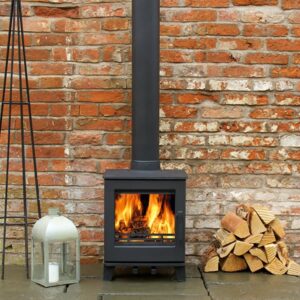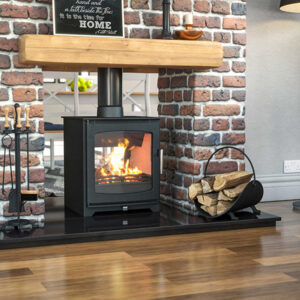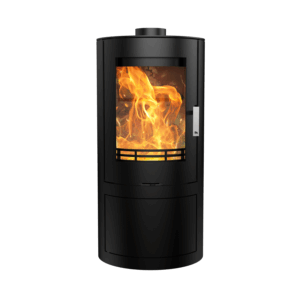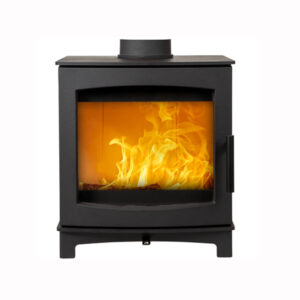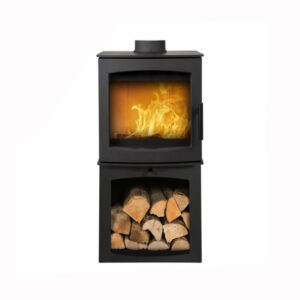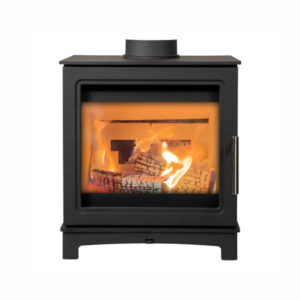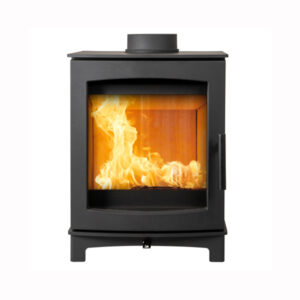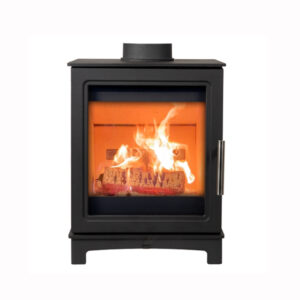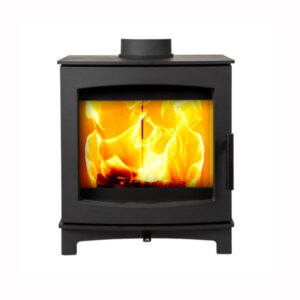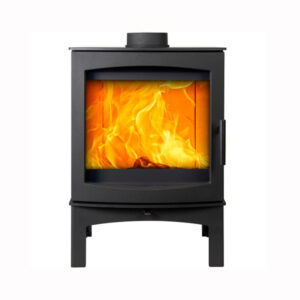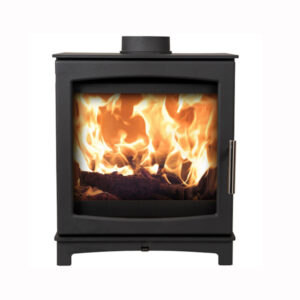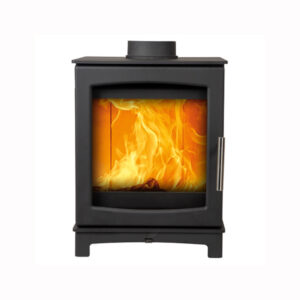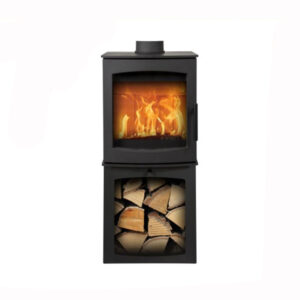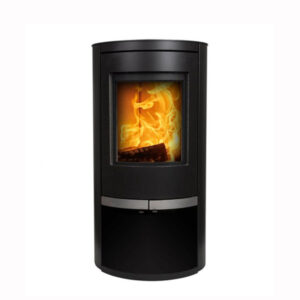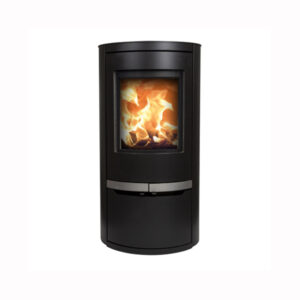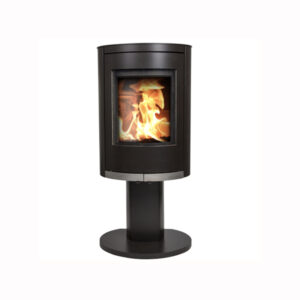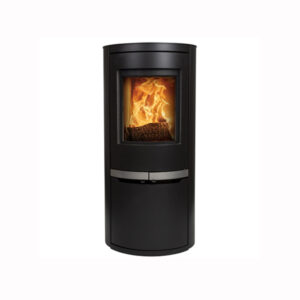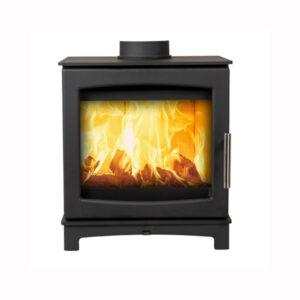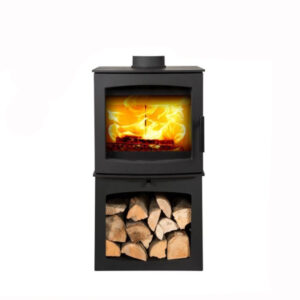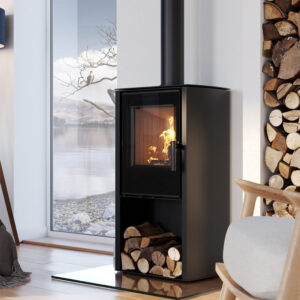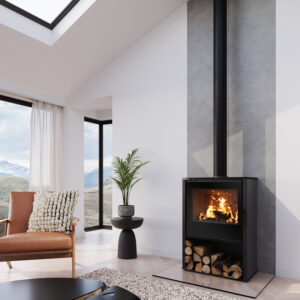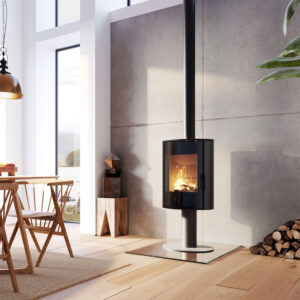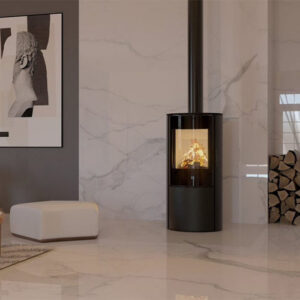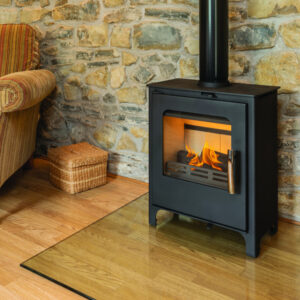Log Burners & Wood Burning Stoves
What are the benefits of a wood burning stove?
An attractive and stylish wood burning stove is also a practical choice:
- It saves you money – log burning stoves are much more efficient than other heating systems. Replacing an old electrical heating system with a wood burning stove could reduce your heating bills by up to £650 a year (Energy Saving Trust)
- It’s environmentally friendly – wood is a carbon neutral fuel, meaning that burning it only releases the same amount of carbon dioxide as the tree absorbed when it was growing
- It’s more efficient than other heating systems – most stoves have an efficiency rating of 60-80%, compared to just 32% for an open fire, and 20-50% for a gas fire
Should I buy a wood burning only or a multi fuel stove?
Wood burning stoves are more effective at burning wood than multifuel stoves are.
This is because fuels burn in different ways, and while the dedicated log burner is designed purely with the efficient burning of wood in mind, multifuel stoves include features that work better for other fuels. For example, the multifuel stove’s riddling plate helps coal burn by allowing air to circulate up to it from underneath, but wood burns best when air reaches it from above.
Knowing which fuels you want to burn is key to helping you identify the right stove for your home.
What type of fuel should I use?
Wood
Wood is a carbon-neutral fuel, meaning that when it is burnt, it only gives off the same amount of carbon as it took in when growing. And because there is very little manufacturing involved in producing logs (none at all if you collect the wood yourself), this type of fuel is very eco-friendly.
Does it matter what type of wood I use?
When choosing wood for your log burner, you should look at both its moisture content and its density. Well-seasoned wood gives off less smoke and burns hotter and more efficiently than wood with high levels of moisture. Hardwood is denser than softwood so has a higher heat content, meaning fewer logs are needed to keep the stove burning for a given length of time; softwood tends to light more easily than hardwood, and burns faster due to its resin content – this means it gives more immediate heat, so is ideal for kindling and initial burning.
Coal
If you’re buying a stove because you want your home to be more environmentally-friendly, bear in mind that coal isn’t a carbon-neutral fuel like wood. There are many forms of coal, from anthracite which is a natural smokeless fuel and burns at very high temperatures to man made smokeless fuel both of which are the only fuels that can be burnt on a standard wood burning stove in smokeless zones. Other types of coal is less clean but cheaper to burn.
Smokeless fuel
There are several different types of smokeless fuels, including naturally-occurring anthracites, smokeless coke or smokeless briquettes. These types of fuels can be used in Smoke Control Areas, and are the only fuels recommended for overnight burning.
Wood pellets
Made from wood by-products such as sawdust, wood pellets are drier and denser than wood logs, making them more efficient and very environmentally-friendly. They are particularly suited to homeowners with oil or bottled gas heating. If you want to burn wood pellets, you’ll need to buy a pellet stove (not a traditional wood burning one).
Eco fuel
Like wood pellets, eco fuel is made from recycled sawdust and clean wood waste, making them eco-friendly and sustainable. Because they are formed into logs rather than pellets, they can be burnt on wood-burning stoves rather than pellet stoves.
How powerful should my stove be (kW)?
Bigger isn’t always better. If you choose a stove that gives out too much heat, you may end up having to keep the windows open to cool the room down, or running the stove at a lower temperature, which will be less efficient.
A stove’s heat output is measured in kilowatts (kW), and will range from 4kW to 16kW. The output that you need will be affected by:
- The size of the room that you want to heat
- Whether you want the stove to be the main source of heat in the room
- How well insulated the room is
Our heat output calculator will help you work out how powerful your stove should be. Stoves have both ‘nominal’ and ‘maximum’ heat output ratings: wherever possible, choose a stove according to its ‘maximum’ heat output rating.
What size stove should I buy?
When choosing your stove, we recommend at least 100mm-150mm clearance to the sides and the rear, and 225mm to the front of the hearth. If your stove will be near combustible materials such as wooden beams and un-coated plasterboard, you need to observe the stoves minimum distances to combustible materials. This is different for every stove and more information can be found in the Technical Details box on all stoves on our website.
Will I be able to comply with building regulations?
All stoves must comply with UK building regulations. There are specifications around how the flue is fitted, the size of the hearth and the distance of the stove from combustibles, all of which may affect the type of stove that you buy.
The regulations can be viewed in full here, but we have also provided a short summary of some of the key ones:
Flues – Height
All stoves need a flue to remove the fumes out of the room and into the atmosphere. Building Regulations recommend a minimum flue system height of 4.5m, although this will vary depending on factors such as the installation of roof windows, the proximity of neighbouring buildings, the pitch of the roof and the roof material (e.g. if your roof is made of combustible materials, such as thatch, you will need a higher flue).
Flues – Diameter
Your flue must be at least as large in diameter as your stove outlet, AND no less than 150mm (or 125mm if your stove is a DEFRA-exempt model). If the diameter of your stove outlet is under 150mm, you must use an adaptor to connect it to the wider flue.
Ventilation
Any stove that is 5.1kw or above will need to have a permanent air vent in the room. The size of the air vent needed depends on the output of your stove – the more powerful your appliance is, the greater the air supply needed. Homes built after 2008 are deemed to be relatively air tight, so require larger ventilators.
Safety
You must install a carbon monoxide monitor in the room where the stove is installed.
With the amount of press recently about wood burning stoves and their impact on the environment many people are confused about what is happening with wood burners, if they are damaging to the environment and what all the different terms are, so here’s a run-down of what is good to know when thinking about a log burner.
Are stoves being banned?
No, stoves are not being banned but there has been a lot of mis-leading headlines recently suggesting that they are. This has all been created by two things: new standards by which stoves are being tested to and a general greater awareness of the importance of our environment. Whilst log burners are carbon neutral, renewable and efficient heat sources, they do produce smoke and in that smoke that are small particles which are harmful to health. Particulates are everywhere, from car exhausts brakes, naturally occurring and anything from outside fires to toasters. This is create by incomplete combustion with small particles of wood going up in the smoke.. The new regulations ensure that modern wood burners produce far less particulates than older stoves and much, much less than open fires. For example a modern wood burner produce about 90% less emissions than an open fire and creates up to 60% less emissions than an older stove. Despite what you might read in the press a modern wood burner is nowhere near as polluting as a car or HGV, which produces about 13 times more particulates per hour. And the new regulations are what measures and ensures a far clearner burn.
EcoDesign Stoves
So the name for the regulations that produced this new breed of highly efficient, clean burning stoves is ecodesign and the term ecodesign ready was termed for any stoves that passed these regulations.
ClearSkies
Now that every new stove solved is an ecodesign compliant stove the industry created the Clearskies rating to show how far the stoves beat the original ecodesign regulations. The higher the rating level, the less emissions that stove produces and the more efficient the stove is.
DEFRA Approved
This is a regulation that has been with us since the 50’s to stop the smogs that occurred in London. It prevents anyone burning wood on an appliance that is not ‘DEFRA Exempt or Approved. Most eco-design stoves are also DEFRA Exempt.
Woodsure Ready to Burn
The other half of the equation is that you need to burn well-seasoned dry wood. The quality of the fuel you burn is essential. Burning high quality, well seasoned wood will lengthen the lfie of your stove and flue and produce far less emissions. Therefore the new Woodsure Ready to Burn mark has been brought in to show that the fuel you are buying meets these guidelines and unseasoned and wet wood is now illegal to sell as fuel.
It is fair to say that the modern stove is a world away from an open fire or an older stove and the stove industry is continually striving to improve the performance and emissions produced by stoves. New designs and innovations are making stoves more efficient than ever and there are new technologies like particulate filters that effectively reduce emissions to practically nothing. You can ask our team for more information about these products if you are interested.
What is a Smoke Control Area?
Many parts of the UK are smoke-controlled areas, which means that you aren’t allowed to emit smoke from a chimney unless you’re burning an authorised fuel, or using an appliance that has been approved by the Department for Environmental, Food and Rural Affairs (DEFRA).
You could be fined up to £1000 for breaking the rules, so it’s worth contacting your local council to find out whether you live in a Smoke Control Area.
I live in a Smoke Control Area – can I still have a wood burning stove?
Yes, as long as you select a model that is ‘DEFRA-exempt’. You can check out our extensive range of DEFRA-exempt wood burning stoves here.
Will I need to re-line my chimney?
If your flue is connected to the chimney (as opposed to running up through the ceiling), you should consider fitting a chimney liner. Without a chimney liner, you may experience a number of problems, including smoke and fumes escaping into other rooms and tar seeping through the chimney and staining the walls.
Will I be able to integrate my stove into my heating system?
Yes. Boiler stoves can be integrated into existing central heating and hot water systems.
Do I need to have a chimney to have a stove?
No. If you don’t have a chimney, a rigid flue system can be built – either straight up and through the roof, or out through the wall and up the side of the building. If you don’t use a chimney, you will need to use an insulated, twin-wall flue pipe.
Can I install my stove myself?
It is possible for a competent DIYer to install a log burner themselves but you must ensure that it complies with Document J in the building regulations and get the installation signed off by your local council. You can also use a local builder or a HETAS registered installer to complete the installation for you.
Do I need planning permission to install a wood burning stove in my home?
You will not need planning permission to install a stove, provided that:
- Flues on the rear or side elevation of the building are no more than a metre above the highest part of the roof
- In a conservation area or World Heritage site, the flue is not fitted on the principal or side elevation if it would be visible from a highway
- The building is not listed or in a designated area (in which case you may need permission for internal alterations too)
- In Scotland, the flue is not in an Air Quality Management Area.
Showing 1–24 of 585 results
-
Original price was: £814.98.£679.99Current price is: £679.99. Inc VAT Add to cart This product has options that may be chosen on the product page
-
Original price was: £1,518.00.£1,222.00Current price is: £1,222.00. Inc VAT Add to cart This product has options that may be chosen on the product page
-
Original price was: £1,216.87.£789.00Current price is: £789.00. Inc VAT Add to cart This product has options that may be chosen on the product page
-
Original price was: £1,479.67.£899.00Current price is: £899.00. Inc VAT Add to cart This product has options that may be chosen on the product page
-
Original price was: £1,109.76.£599.99Current price is: £599.99. Inc VAT Add to cart This product has options that may be chosen on the product page
-
Original price was: £1,063.82.£699.00Current price is: £699.00. Inc VAT Add to cart This product has options that may be chosen on the product page
-
Original price was: £1,041.28.£549.99Current price is: £549.99. Inc VAT Add to cart This product has options that may be chosen on the product page
-
Original price was: £1,140.34.£699.00Current price is: £699.00. Inc VAT Add to cart This product has options that may be chosen on the product page
-
Original price was: £1,304.70.£799.00Current price is: £799.00. Inc VAT Add to cart This product has options that may be chosen on the product page
-
Original price was: £1,216.87.£749.99Current price is: £749.99. Inc VAT Add to cart This product has options that may be chosen on the product page
-
Original price was: £1,063.82.£645.55Current price is: £645.55. Inc VAT Add to cart This product has options that may be chosen on the product page
-
Original price was: £1,343.39.£799.00Current price is: £799.00. Inc VAT Add to cart This product has options that may be chosen on the product page
-
Original price was: £2,100.00.£1,605.39Current price is: £1,605.39. Inc VAT Add to cart This product has options that may be chosen on the product page
-
Original price was: £2,140.32.£1,599.99Current price is: £1,599.99. Inc VAT Add to cart This product has options that may be chosen on the product page
-
Original price was: £2,302.56.£1,699.99Current price is: £1,699.99. Inc VAT Add to cart This product has options that may be chosen on the product page
-
Original price was: £2,221.44.£1,699.99Current price is: £1,699.99. Inc VAT Add to cart This product has options that may be chosen on the product page
-
Original price was: £1,140.34.£689.99Current price is: £689.99. Inc VAT Add to cart This product has options that may be chosen on the product page
-
Original price was: £1,410.05.£849.99Current price is: £849.99. Inc VAT Add to cart This product has options that may be chosen on the product page
-
Original price was: £1,798.20.£1,615.25Current price is: £1,615.25. Inc VAT Add to cart This product has options that may be chosen on the product page
-
Original price was: £1,944.00.£1,754.75Current price is: £1,754.75. Inc VAT Add to cart This product has options that may be chosen on the product page
-
Original price was: £1,979.10.£1,785.00Current price is: £1,785.00. Inc VAT Add to cart This product has options that may be chosen on the product page
Showing 1–24 of 585 results
You can use the Heat Output Calculator to guide you as to the size of wood burning stove that you will need to heat your room.
Which Wood Burner Is Right For Me?
At first there seems to be an endless choice of Wood Burning Stoves to choose from but once you start establishing the needs of your home, you can quickly simplify your options. The main factors to consider are what type of installation are you going to undertake? Decoratively, what are your tastes and the style of your home? What is the size of the living space the stove will be heating? Selecting the correct kW for the right heat output is very important to provide your home with the warmth you expect from your stove. Over-sizing the stove will lead to uncomfortable temperatures and inefficient fuel usage. Please see our Stove Sizing Guide in the Technical Information section of Glowing Embers.
To see what’s popular, check out our most rated, best selling Wood Burning Stoves. If you’re looking for something in particular, be sure to browse our Traditional Stoves and Contemporary Stoves collections!
Fuel
Every stove listed within this section is capable of burning well-seasoned wood efficiently but the majority of models also have the capability to burn coals and smokeless fuels also. Please refer to the technical data of the stove for compatible fuels. Log burners can also be a carbon neutral, eco friendly way to heat your home.
Approvals
At Glowing Embers we only supply Wood Burning Stoves manufactured to CE standard EN13240:2001 for use in the UK. We also clearly mark DEFRA approved stoves!
Installation
No matter where you wish to install your stove, Glowing Embers can supply every component you may need to create a safe and effective flue installation system. Our friendly staff are also on hand to advise on the relevant Building Regulations contained within Approved Document J which impact on your flue system. Fully HETAS and CE approved, our extensive ranges of Twin Wall insulated flue and Flexible Flue Liners help to create every form of flue installation for a domestic stove.
For further information about installing your stove using an existing chimney please see our Chimney Installations section. You can also find out more information about installing Twin Wall flue pipes in our Non-Chimney Installs section. Or give us a call.

